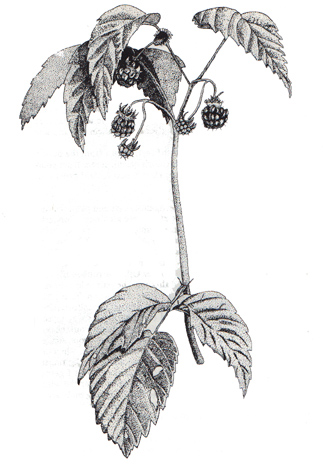
Raspberry
Rubus idaeus
(Rosaceae)

Raspberry
Rubus idaeus
(Rosaceae)
Description:
The fruit of the raspberry bush is so well-known it needs
no description. The genus Rubus includes many other species having the
characteristic raspberry or blackberry-type fruit, with many tiny druplets clustered
together to make a compound fleshy berry. These species all bear edible berries
and most can be used for high-quality leaf tea, although the red raspberry is
the one most widely used for this purpose. The leaves of Rubus idaeus are
compound with three to five leaflets, the flowers are white and clustered, and
the stem is armed with small thorns.
Distribution:
The wild raspberry, from which the cultivated variety has
been derived, occurs naturally all across northern North America and Eurasia
except for the high Arctic and tundra regions. This shrub tends to be a successional
species; thus it is especially common during the first ten years after an area
has been disturbed. Berms and roadsides are likely to be good places to harvest
raspberries.
Constituents:
The berry offers vitamins A, B1, B2, calcium, phosphorus,
and iron, in addition to a fruit sugar, a fragrant volatile oil, citric and
malic acids, pectin, coloring matter, and water. The leaf is high in citrate
of iron and some tannins.
Medicinal uses:
Dried raspberry leaves make a safe, pleasant-tasting
tea that has been highly regarded by both European and Indian peoples for stomach
complaints and as an effective remedy against diarrhea and dysentery, presumably
as a result of its astringent action.
A sure remedy for vomiting and/or diarrhea is to let a strong solution of tea cool to lukewarm and sip slowly.
The tea is recommended as a general tonic for pregnant women. I have known several who drank it freely during their pregnancy and labor and while nursing, under the impression that it served to prevent or alleviate the nausea of morning sickness, promote the general well-being and health of the reproductive system, and prevent premature labor pains. It has been shown in animals to relax the smooth muscles of the uterus and intestine (Spoerke), so it might not be advisable to drink the tea during labor. In the post-delivery period, the tea is said to relieve after-pains. (Christopher)
Externally the tea was used as a wash for sore mouths, wounds or ulcers, and as a gargle for sore throats, especially for young children.
A related plant, R. spectabilis, the salmonberry, has bark and leaves containing an astringent quality. They are pounded or chewed and used as a poultice on burns or wounds. (Gunther)
Culinary use:
The delicious flavor of a fresh red raspberry is a rare
treat, more difficult to buy in some parts of the country than a Rolls-Royce.
Warning:
Although there is no evidence of toxic effects from drinking
raspberry tea, the leaves do contain tannins, so continued use might introduce
the possibility of bowel or kidney irritation. (Spoerke) Also, the leaves must
be completely dried before using--partially wilted leaves can be harmful. (Turner
& Szczawinski) Old dead leaves or twigs are safe so long as they are dry.
My method of drying the leaves is to cut whole stalks and hang them to dry. The brittle leaves can then be removed easily by breaking and crumbling. (The under-dried green leaves are not easily removed by pulling off the stalk.)
Copyright © 1987 by Eleanor G. Viereck